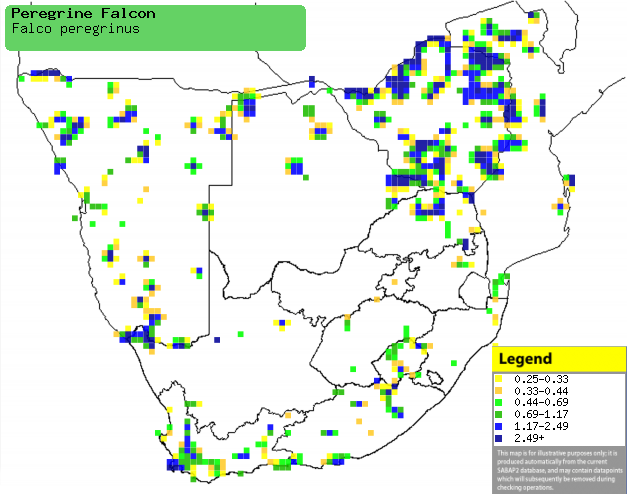|
Falco peregrinus (Peregrine
falcon)
Swerfvalk [Afrikaans]; Ukhetshe (also applied to
Lanner falcon) [Xhosa]; uHeshe (also applied to Lanner falcon) [Zulu]; Kakodi
(generic term for sparrowhawks, goshawks, kestrels and falcons) [Kwangali];
Leubane, Phakoe [South Sotho]; Rukodzi (generic name for a small raptor such as
falcon or sparrowhawk) [Shona]; Rigamani, Rikhozi (generic terms for some
falcons) [Tsonga]; Phakwź (generic term for some of the smaller raptors)
[Tswana]; Slechtvalk [Dutch]; Faucon pčlerin [French]; Wanderfalke [German];
Falcćo-peregrino [Portuguese]
Life
> Eukaryotes >
Opisthokonta
> Metazoa (animals) >
Bilateria >
Deuterostomia > Chordata >
Craniata > Vertebrata (vertebrates) > Gnathostomata (jawed
vertebrates) > Teleostomi (teleost fish) > Osteichthyes (bony fish) > Class:
Sarcopterygii (lobe-finned
fish) > Stegocephalia (terrestrial
vertebrates) > Tetrapoda
(four-legged vertebrates) > Reptiliomorpha > Amniota >
Reptilia (reptiles) >
Romeriida > Diapsida > Archosauromorpha > Archosauria >
Dinosauria
(dinosaurs) > Saurischia > Theropoda (bipedal predatory dinosaurs) >
Coelurosauria > Maniraptora > Aves
(birds) > Order: Falconiformes >
Family: Falconidae
Distribution and habitat
It can be found in every continent of the world excluding
Antarctica, with some sub-species that are resident and with others that are
migratory. Most of the sub-Saharan Africa population is resident, absent
from the equatorial lowland forest of West Africa. In southern Africa it is
generally uncommon and localised in Namibia, northern and eastern Botswana,
Zimbabwe, western Mozambique and South Africa. It generally favours riverine, mountainous or coastal
environments, especially with high cliffs, used for roosting and hunting. Dam
walls, quarries and the tall buildings of city centres can also fulfil this
purpose.
|
 |
|
Distribution of Peregrine falcon in southern
Africa, based on statistical smoothing of the records from first SA Bird
Atlas Project (©
Animal Demography unit, University of
Cape Town; smoothing by Birgit Erni and Francesca Little). Colours range
from dark blue (most common) through to yellow (least common).
See here for the latest distribution
from the SABAP2. |
Movements and migrations
Most of the southern African population (the
subspecies Falco peregrinus minor) is resident and sedentary, however
the migrant Falco peregrinus calidus may also be present in the
region in the period from October-March, and can often be found in
more open habitats than its resident counterpart.
Food
It eats mainly birds, supplemented with bats and flying
insects, catching all of its prey aerially. It does most of its hunting in the vicinity of a
cliff or another tall structure, either hunting from a perch near the top or
from high up in the air, so that it can single out an individual; once it has
done so it dives almost vertically and, due to its aerodynamic shape, can attain
speeds of over 300km/hr! It strikes its prey with its talons at this speed
(killing it instantly), or if it misses it may give pursuit for over two
kilometres before returning to a perch to feed, if the hunt was successful. It
sometimes flies close to the cliff face to flush birds and then chase them, and
it may even rob the nests of cliff-nesting birds. On the whole about a quarter
of its hunts are successful, based on two different South African studies. The following food items have been recorded
in its diet:
Breeding
- Monogamous solitary nester, with pairs sometimes remaining together for as
long as 11 years, both performing spectacular aerial displays in the run-up
to the breeding season.
- The nest is typically a simple scrape in a sheltered ledge or cavity in
a cliff or quarry face; it may alternatively use a stick nest on a cliff of
another bird, such a
Verreaux's eagle or
White-necked raven.
- Egg-laying season is from late July to early November.
- It lays 1-4 eggs, which are mainly incubated by the female for about
32-36 days, while the male occasionally incubates in the day but is mostly
focused on providing the female with food.
- The chicks are brooded constantly by the female for the first few days,
after which she only broods intermittently, stopping completely when they
become about 10-15 days old. The young are fed mainly by the male so that
the female can care for them and defend the nest; they take first flight at
approximately 42-46 days old, only becoming fully independent roughly 1-3
months later.
Threats
Not threatened globally but Near-threatened in South
Africa, probably due to a combination of persecution in city centres,
susceptibility to agrochemicals, nest site disturbance, deforestation and river
impoundment.
References
-
Hockey PAR, Dean WRJ and Ryan PG 2005. Roberts
- Birds of southern Africa, VIIth ed. The Trustees of the John Voelcker
Bird Book Fund, Cape Town.
|
